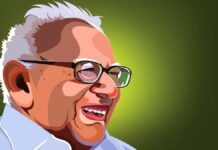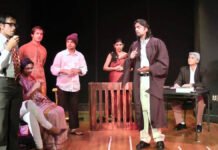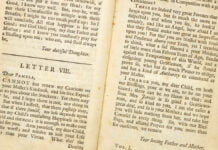Pather Panchali, a vibrant ballad that begins with joy and ends in determination, chronicles the glorious discoveries along the path of everyday life- from spots for secret picnics and the flavour of desserts, to the pleasure of fulfilled dreams and lessons embedded in disappointed hopes. Written by Bibhutibhushan Bandyopadhyay, the Indian-Bengali author and serialised in the Bengali monthly magazine, Bichitra, in the late 1920s, it came out as a book in 1929, stunning the literary world with its originality. In Bengali, Pather means road and Panchali means folk song. So Pather Panchali is The Song of the Road. It is the story of two children, Durga and Opu, growing up poor in a village otherwise rich with forests, a river, a rail track on the edge and magical yarns. It follows a family’s quest to better their lives by moving from an impoverished Bengal region to the larger city of Varanasi (Kashi) in more central-north India. It takes place in regions that were once considered India, but are now in Bangladesh.
The autobiographical tale was adapted for film in 1955 with the directorial debut of Satyajit Ray, who is one of India’s most prominent moviemakers. Popular success follows it even today, and Satyajit Ray has ensured that the novel and its sequel, Aparajito, stay alive in memory with his magnificent trilogy –Pather Panchali, Aparajito and Opur Sansar, made in the 1950s. The story of Durga and Opu was heart-tugging, and the village of Nishchindipur, where they lived with their parents, Shorbojaya and Horihor, and his distant elderly cousin, Indir Thakur, was immortalised in every mind, through the keenly observed lines of Bibhutibhushan, and later because of Ray’s visual perfection.
Themes in Pather Panchali include the political determination of the domestic sphere, identity formation, and the maintenance of dignity. The novel remains a classic of Indian literature for its depiction of how social and political upheaval can determine individual character. The novel is narrated by the youngest boy of the family, Opu. The novel has three parts, divided into each major stage of the family’s journey. The novel opens with the Roy family living in the poor village of Nischindpur, Bengal. The family is headed by Horihor Roy, a Brahmin priest who struggles to provide for his family, as he has poor business skills; he keeps hoping that he’ll make a living as a poet and scholar. In the past, his family made their keep by performing religious rites for ‘clients’. Technically, the profession didn’t pay, but the family received gifts, such as fruits, grain, and on occasion rupees.
Horihor’s wife’s name is Shorbojaya, and he has two children, Opu and Durga. They live with a seventy-five-year-old grandmother named Indir Thakur who spends much of her time complaining about the better, earlier years when the family held much material wealth, not only some diminishing social prestige. Shorbojaya and Indir frequently clash, and after one major fight, Shorbojaya forces Indir to leave the house, which Indir does, dying soon after.
Though the family is Brahmin, the highest rank possible in the caste system, much of the novel centres on Horihor trying to provide a stable upbringing for his family. The family has lost much prestige since the British have lost political power in the region and social reform movements in the 1930s demand a more democratic society. Throughout the novel, the main characters attempt to appear dignified even while they are gradually stripped of material wealth or social respect. Because Horihor is such a dreamer, the day to day matters of running a family are dependent on Shorbojaya. She does this without asking relatives for money or succumbing to low self-esteem. Her pride against asking for help will inadvertently lead to the death of her daughter.
Though the family is visibly poor, Opu and Durga have a great time growing up. Nischindpur in Sanskrit translates to ‘land of the carefree’. The brother and sister love watching rabbits and birds, playing in rivers, and climbing trees. They grow up to be close. Durga teaches Opu the names of every plant and tree. When they are forbidden from entering their wealthy cousin’s fruit gardens, they strike out by themselves to explore the wild forest regions.
Opu admires Durga’s energy and free spirit, despite all the social obstacles she faces. Opu’s character is more like his father. He loves books and writing poems, and listens with great rapture to his mother read the epic Mahabharata. He starts school in an impoverished setting; his teacher also works at the local grocery store. Despite this, he proves himself to be a fast learner. Unlike his sister, Opu is very shy. Durga, the eldest daughter, has less reason to be carefree than Opu. Durga doesn’t receive an education because the family figures she’ll just be married off one day. She also has to manage thrice as many chores as Opu, and unlike him, she never gets away with slackening off. Once, when Durga is accused of stealing sweets from a neighbour and is caught, her mother, Shorbojaya, publically flogs her daughter. Durga’s integrity is effectively destroyed by this public humiliation, but Shorbojaya feels more comfortable having proven the point that she did not approve of the theft and, unlike her daughter, is a good person.
Horihor begins life as an itinerant scholar, believing he can make more money that way. He doesn’t, and the family becomes poorer. They also have to deal with a major hurricane. When Durga becomes fatally ill as a result of the storm, the village lacks medical supplies to help her. Shorbojaya refuses to ask their rich, snooty relatives for help. Their hut begins to leak with rainwater. Durga, agonized with pain and a high fever (yet uncomplaining), dies. Her dying wish is to see a train. Shortly after Durga dies, Horihor finds a job as a private priest for a wealthy family. He returns to the village to share the good news with his family. He has presents for both of his children. When he sees Shorbojaya, she breaks down. They all agree to leave the village to forget their life there. Opu has a tough time with leaving, however, because it feels as if he’s leaving Durga.
The rites-of-passage tale of Opu, who will one day leave the village for the bigger world outside, is brilliant and devastating. “The idea of distance, in general, enchanted him… The high blue arch of the skies above, the disappearing speck of a flyaway kite, the misty indigo field he had seen as a child… all of it made him think of the nebulous adventures that were happening at that very moment, in lands that lay just beyond the average human’s reach.” As for Durga, a child of nature, she knows each tree and fruit, wandering around all day with Opu.
With the larger picture of poverty as a backdrop, Bibhutibhushan weaves in beautiful interludes surrounding the children — Durga sharing slices of raw mango with her brother under a jackfruit tree; Opu seeing a rabbit for the first time; both of them hearing stories of princes and princesses, and the epics; Opu’s first schooling at the local pathshala of Prashonno ‘Gurumoshai’ who ran his class from the tills of his grocery shop; the joy of freedom as the two go in search of the railroad.
The father, Horihor, a priest, is an inadequate provider for his family, and Shorbojaya can barely manage with the little he brings home. On one occasion when Horihor takes Opu along as he travels to other villages, the child is given a large helping of mohonbhog (a sweet halwa made of semolina, nuts, raisins and ghee). Opu then realises what his mother used to make for him at home wasn’t the real thing. Shorbojaya is sometimes harsh to Durga, which Opu doesn’t approve of, but all she wants is a better life for her children. She worries about Opu’s health and Durga’s frequent bouts of malaria.
Satyajit Ray said he chose Pather Panchali for the qualities that made it a great book: “its humanism, its lyricism, and its ring of truth.” Bibhutibhushan’s encyclopaedic map of rural Bengal — now mostly lost — and its people, and the contrasts between “the rich and the poor, the laughter and the tears, the beauty of the countryside and the grimness of poverty existing in it,” made it a perfect tale for a scenarist like Ray. This chronicle of a brother and sister, their innocent pursuit of little joys in the hope that one day they will get to experience the wonders of the world, mirrors the universal aspirations of growing up. Not everyone makes it like Opu; many are fated to miss out like Durga. Pather Panjali closes with the remaining family members boarding a train for the holy city of Kashi. They all believe they’ll have a better future in Kashi, but Opu keeps thinking of his sister’s dying wish to travel on a train one day.





























